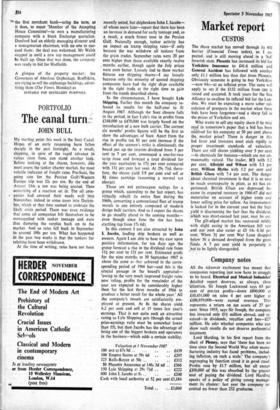The canal turn
PORTFOLIO JOHN BULL
My starting point this week is the Suez Canal. Hopes of an early reopening have fallen sharply in the past fortnight. As a result, shipping, in spite of the rapid advance in values since June, can stand another look. Before looking at the shares, however, one must assess the tanker charter market, the most volatile indicator of freight rates. Pre-Suez, the going rate for the Persian Gulf/Western Europe trip was 32s per ton. By the end of August 134s a ton was being quoted. Then sonielhing of a reaction set in. The oil corn- • panies had covered their needs well into November, indeed in some cases into Decem- ber, which at that time seemed to embrace the likely crisis period. There was even evidence that some oil companies felt themselves to be oversupplied with tanker tonnage and were thus dumping the surplus back on to the market. And so rates fell back in September to around 100s per ton. What has happened in the past two weeks is that the tankers for reletting have been withdrawn.
At the time of writing, rates have not been recently tested, but shipbrokers John L Jacobs— of whom more later—report that there has been an increase in demand for early tonnage and, as a result, a much firmer tone in the Persian Gulf. Naturally enough, tanker activity has an impact on tramp shipping rates—if only because the war withdrew oil tankers from the grain trades. September rates were 20 per cent higher than those available exactly twelve , months earlier, though again the July prices were even better. Loosely tied to these market fixtures are shipping shares—I say loosely because only the minority of quoted shipping companies have had the right ships available in the right trade at the right time to gain from the trends described above.
In the circumstances, I have bought Lyle Shipping. Earlier this month the company re- leased its results for the half-year to 31 August 1967. Although the Suez closure falls in the period, in fact Lyle's rise in profits from £348,000 to £470,000 was largely based on the introduction of a new bulk carrier. The current six months' profits figures will be the first to show the advantages of Suez. Apart from the rise in profits (an 83 per cent increase if the effect of the seamen's strike is eliminated), the board put up the interim dividend from 5 per cent to 7 per cent, announced a one-for-two scrip issue and forecast a total dividend for the year equivalent to 171 per cent compared with 133 per cent last year. At 29s 7+d, there- fore, the shares yield 5.9 per cent and sell at 81 times earnings (assuming a normal tax charge).
Those are not extravagant ratings for a group which, according to the last report, has virtually rebuilt its entire fleet during the 1960s, converting a conventional fleet of tramp vessels to one entirely composed of modern design bulk carriers. And so I expect the shares to go steadily ahead in the coming months— even though since June the rise has been startling (up from 17s 6d).
In this context I am also attracted by John I. Jacobs, leading ship brokers as well as owners. Again I am able to base my case upon positive information, for ten days ago the group forecast a rise in the dividend rate from 111 per cent to 123 per cent. Estimated profit for the nine months to 30 September 1967 is about the same as that achieved in the corre- sponding period of 1966 but—and this is the crucial passage in the board's appraisal— 'owing to the very much improved freight rates now ruling, profits for the remainder of the year are expected to be considerably higher than for the last three months of 1966 to produce a better result for the whole year.' All The company's vessels are satisfactorily em- ployed at present. At 8s the shares yield 6.2 per cent and sell at 15 times last year's earnings. That is not quite such an attractive rating as Lyle Shipping gets (though the actual price-earnings ratio must be somewhat lower than 15), but then Jacobs has the advantage of being one of the biggest brokers and operators in the business—which adds a certain stability.
Valuation at 1 November 1967
100 BAT at 87s 9d
£439 100 Empire Stores at 59s 6d .. £297 125 Rolls-Royce at 50s £312 50 Phoenix Assurance at 146s Id xd £366 150 Lyle Shipping at 29s 7+d £222 600 John I. Jacobs at 8s £240
Cash with local authority at 53 per cent £3,184
Total .. £5,060










































 Previous page
Previous page